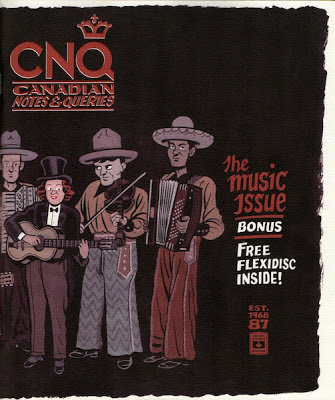Death by Deficit: A 2001 Novel
Richard Rohmer
Toronto: Stoddart, 1995
There are plenty of villains in this novel – Quebecers, bankers, the Japanese, a CBC reporter with beer on his breath – but only one appears more than fleetingly. This would be the unnamed former prime minister, a "burned-out politician" whose "lined round face was recognized by everyone in Canada."
I recognized him as Paul Martin, our twenty-first prime minister.
Rohmer's twenty-first prime minister is one of "the architects and the builders of
the crisis." The emphasis, mine, is wholly justified.
Death by Deficit is set in an imagined 2001, a future past, during the earliest days of the greatest crisis Canada has ever faced. Rohmer's twenty-second prime minister – known only, perhaps tellingly, as "Richard" – has just been sworn in when the economy collapses.
Not his fault. Blame Paul Martin, Jean Chrétien, Brian Mulroney, Pierre Elliott Trudeau and their years of reckless deficit spending. As the country's accumulated debt approaches one trillion dollars, the Japanese get jittery and start dumping their Canadian bonds and securities. Richard announces to the assembled media that he is certain the Americans and Europeans will do likewise.
Which they then do.
Which is meant to show how smart he is.
This reader thinks he's an idiot – and not just for that self-fulfilling prophecy. I'm sure the author wouldn't see it that way. Rohmer's Richard is a hero. The leader of a new party created by the merger of Reform and the Progressive Conservatives, he sees crisis as an opportunity to do whatever the hell he wants: slashing the civil service, privatizing Crown corporations, ending foreign aid, giving "Indians" the what for and, of course, slamming the door on immigration.
I once wrote about this type of story in reference to
a fantasy Preston Manning published in the Globe & Mail. Masturbatory to those who favour the right, I called it porn. It is. The U of T's Sylvia Ostrey can hardly contain her excitement: "As usual, Richard Rohmer tells a gripping tale – but this time about fiscal policy!"
Former Progressive Conservative MP James Gillies joins in: "
Death by Deficit uncannily captures the atmosphere which dominates the House, the caucus, and the Cabinet when there is a crisis."
Bullshit.
There's never been a crisis in which a PM has called for the RCMP to be brought in to House of Commons to quell dissent.
Not yet, anyway.
Richard snubs his Cabinet and meets with his neophyte caucus only to deliver a false primer on "the parliamentary principle of party discipline."
Enter that beery-breathed CBC reporter, who dares make the very observation that Richard did behind closed doors:
"You have a new, inexperienced Cabinet filled with people who don't even know how to find a washroom in this place, let alone how to handle this crisis. Don't you think you should get some help, call in the best brains in the country?"
A fair question, it's followed by others until Richard changes the channel (pun intended):
"There is no longer any justification for the continuation of the Canadian Broadcasting Corporation and its enormous drain on the public purse."
So ends the CBC. Cut the mike.
The prime minister never calls in "the best minds in the country", rather he phones
Allan Greenspan Al Weinstock, Chairman of the Federal Reserve of the United States.
Weinstock states the obvious:
"…you'd better open the IMF and World Bank doors. At least knock on them and let them know you're coming."
As if he hasn't already helped enough, the Chairman of the Fed gives Richard some phone numbers.
Accompanied by Abbi Black, his very hot "director of international studies," Weinstock flies to Ottawa, susses out the situation, and presents the "Weinstock Solution": Washington will take on Canadian debt in exchange for free access to the country's fresh water, abrogation of cultural protection and unobstructed negotiations that would see British Columbia absorbed by the United States.
Richard accepts the proposal with thanks. No negotiation necessary. No need to call the President.
God, what a mess. It's not like we didn't see it coming.
Remember that 1993 episode of
W5 devoted to New Zealand's meltdown?
Sure you do. After all, the reporter was "one of Canada's best, probably the best, TV news magazine producer, Eric Malling." American Abbi Black thinks so much of the show that she presents the entire transcript to Richard, his Minister of Finance, the President of the Treasury Board and, ultimately, the reader. Thirty pages of disjointed prose follow.
"There's been some criticism of the program," hot Abbi acknowledges, "but it's okay for our purposes."
Criticism? Well, yes. In fact, Malling's report inspired Linda McQuaig's
Shooting the Hippo: Death by Deficit and Other Myths, which laid bare Malling's… let's say "stretching of the truth."
Published six months before Rohmer's novel, McQuaig's
Shooting the Hippo: Death by Deficit and Other Myths dominated the 1995 bestseller lists and was shortlisted for a Governor General's Award for English-language Non-Fiction.
Rohmer's
Death by Deficit is, of course, pure fiction. You can tell because he inflates Canada's 1993-94 debt, has it that Employment Insurance is a drain on our taxes and repeats that old saw about Francophones controlling the civil service.
Think of it all as a novelist's prerogative.
Still, I can't help but think that Rohmer believes these things, just as I'm certain he believes the PM's warped version of parliamentary democracy is spot on.
Death by Deficit is our world, but a little off, like cheese that's been left out too long smeared over the pages of
The Plot Against America. In Richard Rohmer's Canada a female Governor General delivers the "Speech From [
sic] the Throne" decked out like Eliza Doolittle at the Embassy Ball.
Death by Deficit predicts a Chrétien government that paid no attention whatsoever to the growing national debt, when in fact it began paying off same with record surpluses. Credit belongs to Paul Martin, who is referred to in the novel as a "lying bastard".
I'll hand the author this: Paul Martin did indeed become our twenty-first prime minister. What's more, our twenty-second, Stephen Harper, leads a party born of a merger of Reform and the Progressive Conservatives. What Rohmer gets wrong is that the Harper government has run the largest deficits in Canadian history, raising us to unprecedented heights of public debt.
What he gets right is that, like Richard's party, Stephen's votes as one.
Sheep.
Trivia: In
Generally Speaking: The Memoirs of Major-General Richard Rohmer, the author describes Paul Martin as "a good friend of mine." Rohmer isn't mentioned in
Hell or High Water, Martin's autobiography.
Best passage:
It was Abbi Black who was the sight to behold. The PM's male hormone computer told him she was one of the most strikingly beautiful women he had ever laid eyes on. His computer went up a further notch when she slipped off her heavy coat and white scarf. This tall, high-healed, long-limbed, slim beauty was wearing a tight-fitting black woollen sheath with a gleaming row of golden buttons running down from the discretely low-cut bodice that covered her firm breasts (just the right size, according to his computer).
His eyes took in the cascade of wavy ebony hair and the smooth, unlined forehead, the black, well-shaped eyebrows arched over eyes that held deep-brown pupils in their centres. Her nose was perfectly shaped, her high cheekbones led to a wide, full-lipped mouth with exquisite teeth.
The PM liked – very much – what he saw, but there was serious business at hand, and he switched off his internal computer as he shook Abbi Black's soft, well-manicured hand.
Highest concentration of hyphens in Canadian literature (but that's not why I point it out).
Bonus:
The doors of the Speaker's chambers opened. There the Right Honourable Pearl McConachie stood in radiant white, her long form-fitting gown reaching to the scarlet carpet. He sleeved arms were partly concealed by a purple cape that sat on her slender shoulders. The wavy blond hair was fetched upwards, seemingly encased in a delicate, glittering tiara.
Object and Access: A well-padded 234-page hardcover in Tory blue boards, my copy set me back 60¢ last summer. Online booksellers offer a dozen or so at prices ranging from $4.11 to $38.74. Condition is not a factor. Pay no more than 60¢.
Death by Deficit was printed only once and has never come out in paperback, meaning all copies out there are first editions. Pay no more than 60¢.
Thirteen of our academic libraries have copies, as does Library and Archives Canada. Public library users will find the book in the Calgary Public Library, the Red Deer Public Library, the Medicine Hat Public Library and the Toronto Public Library.
Related posts:























































